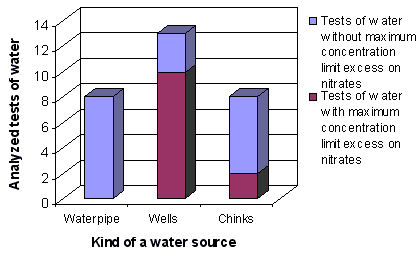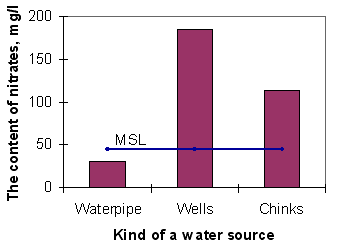 |
Russian
|
Russian
 |
|
|||||||||||||||||||||||||||||||
 About author
About author
|
||||||||||||||||||||||||||||||||
AbstractActuality: 1) There are no information about the degree of pollution of biological objects by fluorides and nitrates; 2) Remarkable biological activity and high toxicity of fluorides and nitrates make studying of processes of their transformation and migration really necessary. The work purpose – to define the content of fluorides and nitrates in natural waters of residential districts of Donetsk area. Scientific novelty – to carry out an estimation of pollution degree of natural waters with nitrates and fluorides using maps-schemes for the first time. The problems of the recent researches were: 1) gathering and analysis of the information concerning the sources, toxicity of nitrates and fluorides, and also methods of definition of their content in natural waters of residential districts of Donetsk area; 2) selection and the analysis of tests of water; 3) processing of results of water-tests research; 4) drawing up of the cards-schemes describing degree of pollution by nitrates and fluorides. An acute problem of our time is unsupervised environmental contamination connected with human activity. Pollution of water resources, in particular drinking water of residential districts, is especially dangerous as their reserves are limited. Ukrainians receive drinking water not only from systems of the centralised water supply. Approximately third of population of the country uses water from underground sources. Usually it is rural wells. Soil and underground waters are often used by the population for the drinking purposes, meanwhile they tend to accumulate toxic substances. In this connection researches and the control of underground waters which are used for the drinking purposes are expedient. NitratesFluoridesIn a human body fluorides could get with water, food, medical products, pesticides, and the considerable part of them is the result of human activity. Water researchesThe straight potentiometric method with the use of ionic-selective to nitrates-ions electrodes is one of the fastest and exact methods with the help of which the content of nitrates could be defined. The device, which principle of action is based on this method, is called nitrometer. Data about the content of nitrates in tests of water from different water sources of area is resulted in table 2. Table 2 – the content of nitrates in tests of water from different water sources
In picture 1 it is shown quantity of tests of water with excess of the content of nitrates from total of analyzed tests of water.  Drawing 1 – The relation of tests of water with maximum concentration limit excess on nitrates to total of tests of water Received data testifies that 77 % of the analyzed samples of water from drinking wells have the content of nitrates above maximum concentration limit (for nitrates makes 45,0 mg/l). This indicator in analyzed water exceeds maximum concentration limit in 2,00 – 11,0 times (drawing 2, 4).  Drawing 2 – Comparison of the average content of nitrates in tests of water of various water sources  Drawing 3 – Comparison of the maximum content of nitrates in tests of water of various water sources The greatest content of nitrate ions is observed in water of wells in Jelane-village (Jasinuvatskiy area) – in 11 times of excess of maximum concentration limit – and in Krasnoe-village (Krasnoarmijskiy area) – in 7 times of excess of maximum concentration limit. Also it was found out that fluctuation of the content of nitrates is observed – from 3,1 to 460,0 mg/l in well water, and from 2,6 to 525,0 mg/l in water from chinks. Thus, the control over the content of nitrates and fluorides in water is the important problem. Reduction of receipt of nitrogen in geological circulation is possible if to accept following measures: 1 strengthening of biological circulation by normalised use of fertilizers; 2 their even distributions on a surface of fields; 3 cultivation of slopes to decrease a superficial drain as much as possible. © DonNTU 2009 Prokopenko Natalia | ||||||||||||||||||||||||||||||||
 About author
About author
|
||||||||||||||||||||||||||||||||